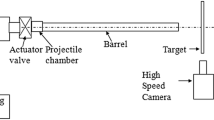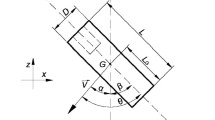Abstract
Ballistic performance of ductile targets is the most important factor for the safety of defense/protective structures such as shelters for armed conflict, bunkers for military liveware etc. In the present study, a three-dimensional numerical simulation is carried out using ABAQUS to study the effects of caliber radius head (CRH) value on the ballistic resistance of aluminum plates under normal bullet impact. The Johnson-Cock (JC) constitutive model was used to carry out the numerical simulations. The monolithic AA-7075 target of uniform thickness having size 100 × 100 mm were impacted by two different bullets with CRH value 1.0 and 2.5. The weight and radius of the bullet body were kept identical in all the simulations. The target plate was restrained from all four sides. The impact velocity of the bullet varied from 0.65 to 1.5 km/sec and the response of the target i.e., energy dissipation, damage, reaction force, etc. were obtained and compared. For a given impact velocity, the residual velocity of the projectile with CRH 1.0 was noticed higher than that for the projectile with CRH 2.5. In general, the reaction and energy absorption of the plate was noticed smaller against the projectile with CRH 2.5 when the impact velocity was closer to the ballistic limit. Projectile with CRH 1.0 and CRH 2.5 failed the ductile target through enlargement of the hole. The ballistic impact was critical in terms of hole enlargement and failure mode for a projectile with CRH 1.0 because of the sharper nose and smaller contact area and also longer ballistic length.
Access provided by Autonomous University of Puebla. Download conference paper PDF
Similar content being viewed by others
Keywords
1 Introduction
From the civilian and military point of view, there is a great need for the safety of defense/protective structure such as shelters for armed conflict and bunkers for military liveware; most of the studies on ballistic impact was focused on the normal impact conditions because the normal incidence condition is one of the worst critical situations for predicting the target performance. Several researchers [1,2,3,4] discussed the effects of different parameters like projectile nose shape, diameter, target thickness, and impact velocities on the older alloys of aluminum which are either not used or rarely used nowadays for designing defense/protective structures. The aluminum 7075-T6 is most widely used because of better important properties like greater strength, light in weight, etc. It has very good mechanical properties and exhibits good ductility, toughness, and good fatigue resistance. Other advantages of this material are that it is free from low-temperature embrittlement and provides greater rigidity, hence this material is most commonly used for highly stressed structural applications. In the present study, the effects of CRH value 1.0 and 2.5 were studied on the response of the target, i.e., energy dissipation, ballistic limit, residual velocity, reaction force, and damage profile against the impact velocity varied from 0.65 to 1.5 km/sec.
2 Constitutive Modeling
The finite element analysis was carried out for studying the material behavior of 7075-T6 Aluminum alloy [5] using the Johnson–Cook elasto-viscoplastic model [6, 7]. The model considers high strain rates sensitivity, larger deformation, yielding, plastic flow, and thermal softening. The equivalent von-Mises stress (\(\tilde{\sigma }\)) in the Johnson–Cook model is defined in Eq. (1)
where A, B, C, n, and m represent the yield stress, hardening constant, strain rate sensitivity hardening exponent, and thermal softening exponent, respectively. \({\overline{\varepsilon }}^{Pl }\) is equivalent plastic strain, \({\dot{\overline{\varepsilon }}}^{Pl}\) is equivalent plastic strain rate, \({\dot{\varepsilon }}_{0}\) is a reference strain rate, and \(\overline{T }\) is non-dimensional temperature can be written in Eq. (2)
where T is the current temperature, \({T}_{m}\) is the melting point temperature, and \({T}_{0}\) is the room temperature. The fracture model proposed by the Johnson–Cook model includes the effect of stress triaxiality, strain rate, and temperature on the equivalent failure strain. The equivalent fracture strain \({{\overline{\varepsilon }}_{f}}^{Pl}\) is expressed in Eq. (3)
where \({d}_{1} to {d}_{5}\) are material parameters, \(\frac{{\sigma }_{m}}{\tilde{\sigma }}\) is the stress triaxiality ratio, and \({\sigma }_{m}\) is the mean stress. The Johnson–Cook parameter and material properties used in this study are given in Table 1.
3 Finite Element Method
The finite element model of the target and the projectile was developed using three-dimensional modeling using ABAQUS/EXPLICIT. The projectile and target plate were modeled as the solid deformable body. The caliber radius heads (CRH) of ogive nosed projectiles was varied keeping the weight and radius constant for all the simulations. The surface-to-surface contact between the projectile and the target was modeled considering kinematic contact and employing friction at the interface. The projectile was considered as the master surface and the contact region of the plate as the slave surface. The target plate is restrained from all four sides while the projectile was given an impact velocity. The dimensions of the target plate are 100 × 100 mm with a thickness of 6 mm. The meshing in the finite element model is shown in Fig. 1. The total number of elements in the model was approximately 396 k. The ballistic limit was studied for different impact velocities which were ranging from 650 to1500 m/sec.
4 Results and Discussion
4.1 Residual Velocity and Energy Dissipation During Impact
The relation between the residual and impact velocity is shown for both the CRH values in Fig. 2a. The residual velocities were noticed 1314 and 1280 m/sec for CRH 1.0 and CRH 2.5, respectively, at the impact velocity 1500 m/sec. The residual velocity decreased with a decrease in the impact velocity exhibiting almost linear proportionality. The ballistic limit for CRH 1.0 was noticed to be relatively higher compared to CRH 2.5 of the target noticed. The ballistic limits were 750 and 700 m/sec for CRH 1.0 and 2.5, respectively (see Fig. 3). In general, the energy dissipation was nominally reduced with a decrease in the impact velocity. The energy dissipated by the plates were noticed at 2.07 and 1.87 kJ for CRH value 1.0 and 2.5, respectively, at the ballistic limits, see Fig. 2b.
4.2 Computation of Reaction Force During Impact
The plots of reaction force vs time are shown in Figs. 4a and b for CRH values 1.0 and 2.5, respectively. In general, the reaction force decreased with a decrease in the impact velocity. For CRH value 1.0, maximum values of reaction force were noticed 253.61, 198.39, and 149.67 kN for the impact velocity of 1500, 1000 m/sec and at ballistic limit, respectively. Similarly, for CRH value 2.5, the magnitude of maximum reaction force was 258.50, 190.16, and 132.16 kN for the impact velocity of 1500, 1000 m/sec, and ballistic limit, respectively.
4.3 Failure Modes
Figures 5a and b shows the failure modes of the monolithic aluminum target impacted by the projectile with different impact velocity for CRH 1.0 and 2.5, respectively. The mode of failure is influenced by the caliber radius head of the projectile. CRH 1.0 projectile failed the ductile target through enlargement of the hole which were 7.69, 8.19, and 8.98 mm in size for impact velocity of 1500, 1000, and 750 m/sec, respectively. Similarly, CRH 2.5 projectile failed the ductile target through enlargement of the hole which were 7.70, 7.52, and 8.50 mm in size for impact velocity of 1500, 1000, and 700 m/sec, respectively. Also, it is found that the projectile with CRH 1.0 creates a critical role in terms of hole enlargement as compared to CRH 2.5 at impact velocity of 1000 m/sec and irrespective of their ballistic limit. This is because the projectile nose became sharper with decrease in CRH value from 2.5 to 1.0; therefore, it is more quickly to hit the object with a longer ballistic length. However, there is no significant change (almost constant) in terms of hole size at impact velocity of 1500 m/sec due to the high impact velocity.
5 Conclusions
The ballistic performance of 7075-T6 aluminum alloy targets is studied under varying impact velocity under the normal impact of projectile (dia. 7.62 mm). Numerical simulations are carried out to determine the ballistic performance using Johnson–Cook constitutive model. The study showed that the ballistic limit of the aluminum plate decreased with an increase in CRH value from 1.0 to 2.5. The ballistic limit was 700 and 750 m/sec for the projectile with CRH 2.5 and 1, respectively. For a given impact velocity, the residual velocity of the projectile with CRH 1.0 was noticed higher than that for the projectile with CRH 2.5. In general, the reaction and energy absorption of the plate was noticed smaller against the projectile with CRH 2.5 when the impact velocity was closer to the ballistic limit. Projectile with CRH 1.0 and CRH 2.5 failed the ductile target through enlargement of the hole. The ballistic impact was critical in terms of hole enlargement and failure mode for a projectile with CRH 1.0 because of the sharper nose and smaller contact area and also longer ballistic length.
References
Khan SH, Azeem M, Ansari R (2010) Numerical simulation of ogive nose projectile impact on aluminum plates of different thicknesses, pp 27–29. https://doi.org/10.1243/09544062jmes1523
Iqbal MA, Gupta G, Gupta NK (2010) 3D numerical simulations of ductile targets subjected to oblique impact by sharp nosed projectiles. Int J Solids Struct 47:224–237. https://doi.org/10.1016/j.ijsolstr.2009.09.032
Gupta NK, Iqbal MA, Sekhon GS (2008) Effect of projectile nose shape, impact velocity and target thickness on the deformation behavior of layered plates. Int J Impact Eng 35:37–60. https://doi.org/10.1016/j.ijimpeng.2006.11.004
Iqbal MA, Gupta G, Diwakar A, Gupta NK (2010) Effect of projectile nose shape on the ballistic resistance of ductile targets. Euro J Mech A/Solids 29:683–694. https://doi.org/10.1016/j.euromechsol.2010.02.002
Sundaram SK, Bharath AG, Aravind B (2022) Influence of target dynamics and number of impacts on ballistic performance of 6061–T6 and 7075–T6 aluminum alloy targets. Mech Based Des Struct Mach 50:993–1011. https://doi.org/10.1080/15397734.2020.1738245
Johnson GR (1983) A constitutive model and data for materials subjected to large strains, high strain rates, and high temperatures. In: Proceeding 7th information symposium ballistics, pp 541–547
Johnson GR (1985) Fracture characteristics of three metals subjected to various strains, strain rates, temperatures and pressures, pp 31–48
Acknowledgements
The authors sincerely thanks Dr. M. A. Iqbal, IIT Roorkee, India, and Dr. Venkatesan J, SERC Chennai, India, for helping in carrying out numerical simulations.
Author information
Authors and Affiliations
Corresponding author
Editor information
Editors and Affiliations
Rights and permissions
Copyright information
© 2024 The Author(s), under exclusive license to Springer Nature Singapore Pte Ltd.
About this paper
Cite this paper
Kumar, R., Kumar, V. (2024). Effect of CRH Value on Damage Resistance of Aluminum Plate Under Bullet Impact. In: Velmurugan, R., Balaganesan, G., Kakur, N., Kanny, K. (eds) Dynamic Behavior of Soft and Hard Materials Volume 1. IMPLAST 2022. Springer Proceedings in Materials, vol 34. Springer, Singapore. https://doi.org/10.1007/978-981-99-6030-9_3
Download citation
DOI: https://doi.org/10.1007/978-981-99-6030-9_3
Published:
Publisher Name: Springer, Singapore
Print ISBN: 978-981-99-6029-3
Online ISBN: 978-981-99-6030-9
eBook Packages: Chemistry and Materials ScienceChemistry and Material Science (R0)









